Understanding Blood Clots: Causes, Symptoms, and Prevention
Blood clots are essential for the body’s natural healing process. When you have a cut, your body forms a blood clot to stop the bleeding and begin the healing process. However, sometimes clots can form in the wrong place or fail to dissolve naturally, leading to serious health risks. In this blog, we’ll discuss the causes, symptoms, and prevention of dangerous blood clots.
What Are Blood Clots?
Blood clots, or thrombi, occur when blood coagulates or thickens to form a solid mass. While this is a necessary function in response to injury, clots can also form without an injury and become dangerous when they block blood flow in veins and arteries.
Types of Blood Clots
- Deep Vein Thrombosis (DVT): DVT is a clot that forms in deep veins, usually in the legs, but can occur in other areas such as the arms. It can cause pain, swelling, and other symptoms.
- Pulmonary Embolism (PE): PE is a life-threatening condition where a blood clot from another part of the body, often the legs, travels to the lungs and blocks an artery.
- Arterial Thrombosis: This occurs when a clot forms in an artery, blocking blood flow to vital organs like the heart or brain. It can lead to heart attacks and strokes.
Causes of Blood Clots
Blood clots can form due to a variety of reasons, including:
- Inactivity: Prolonged periods of immobility, such as during long flights or hospital stays, can increase the risk of clots.
- Surgery or Injury: After surgery or injury, your body produces more clotting factors to help heal the wound.
- Certain Medical Conditions: Conditions such as heart disease, cancer, and autoimmune disorders can increase clotting risk.
- Genetics: A family history of blood clots can predispose someone to clotting disorders.
- Hormonal Changes: Pregnancy, hormonal therapy, and birth control pills can elevate the risk of clotting.
Symptoms of Blood Clots
The symptoms of blood clots depend on their location and type. Common symptoms include:
- Pain or swelling: Typically in the leg or arm where a DVT is present.
- Shortness of breath: A sign of pulmonary embolism.
- Chest pain: Can indicate a blood clot in the lungs or heart.
- Numbness or weakness: May suggest a clot affecting the brain.
Prevention of Blood Clots
There are several ways to reduce your risk of developing dangerous blood clots:
- Stay Active: Regular exercise and movement can help prevent blood clots, particularly during long periods of immobility.
- Maintain a Healthy Weight: Being overweight increases the risk of blood clots.
- Manage Medical Conditions: Proper management of conditions like diabetes and hypertension can lower the risk of clots.
- Stay Hydrated: Proper hydration helps keep blood from thickening and reduces the risk of clots.
- Avoid Smoking: Smoking increases the risk of clotting and other cardiovascular problems.
- Consult Your Doctor: If you are on birth control pills, hormone therapy, or have a family history of blood clots, discuss your risk factors with your healthcare provider.
See the full scientific article from Pfizer.
By understanding the causes and symptoms of blood clots and taking steps to prevent them, you can protect yourself and maintain good vascular health. Always consult a healthcare professional if you suspect you may have a blood clot or are concerned about your risk.
It’s a fantastic idea also to incorporate supplements from the Asher Longevity Institute. By doing so, we can enhance your body’s overall health and well-being.




